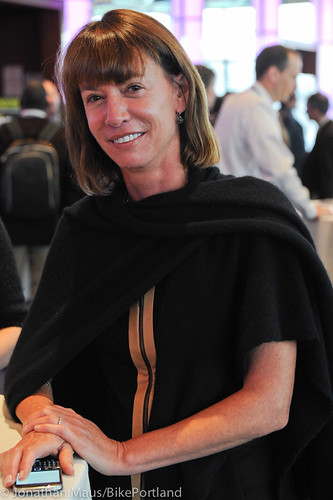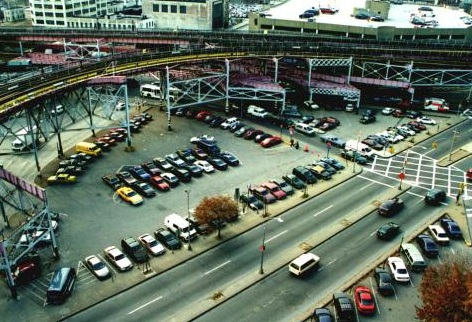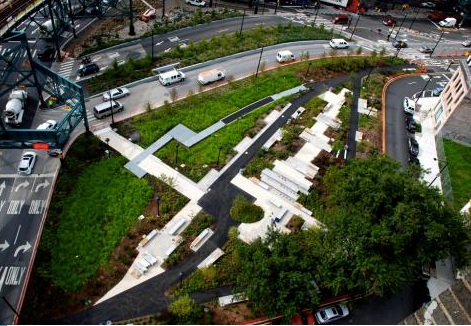
at the Kimmel Center on the campus of NYU.
(Photos © J. Maus/BikePortland)
Yesterday during the NACTO Designing Cities conference I got the (unexpected) opportunity to sit down with New York City Department of Transportation Commissioner Janette Sadik-Khan.
“I don’t think people thought you could change the streets in New York.”
For the uninitiated, Sadik-Khan is as close to a rock star as you’ll find in the transportation world. Since taking over New York City’s top transportation job in 2007 (and its 4,700 employees and $2 billion per year budget) she has ushered in a new era by transforming streetscapes from car-choked jungles into vibrant public spaces where people on bikes, on foot, and on transit are given safer, more pleasant, and more efficient options. She has overseen the implementation of 300 miles of bike lanes since 2006, many of them physically separated from auto traffic. Sadik-Khan is also credited with taming New York City’s streets by replacing scores of auto parking spaces with park benches and miles of auto lanes with trees and plants. (Stay tuned for a closer look at some of her handiwork.)
Her style and substance has earned wide acclaim; but it’s also been met with considerable “backlash” from New Yorkers resistant to change and a media all too eager to encourage a fight.
Sadik-Khan addressed that backlash and several other topics in the interview which I’ve transcribed below.
“I think it was change on the streets, which hadn’t really happened in decades. You know, people get used to doing things the same way, so when you come out your front door and see things are different, it can be jarring. And it takes a little while to get used to change. I think what you’ve seen now over the last couple of years is that it [the backlash] has largely died down. I think some of the initial media coverage was overblown. And it sells newspapers. Consensus doesn’t sell newspapers.
Also, now that the tabloid ink has dried and some of the screaming has died down, you’re seeing that, actually, public opinion is strongly behind this investment strategy because people understand that if we’re going to continue to grow and thrive we have to do things differently. And bike lanes actually make the city safer; and pedestrian plazas are important quality of life improvements in communities. They’re good for business. It’s hard to argue with getting on a bus that cleaner, faster and more convenient.
These are really basic enhancements to a transportation network that was long overdue for an overhaul.”
(Below are before/after images of the Queens Plaza North project)


“I wasn’t scared about whether it would work or not. It’s a fairly straightforward approach and it really is all about balance. New York City has a really strong mix of travelers; about one-third get around by walking, one-third get around by transit, and one-third get around by driving, so we needed to have an investment strategy that reflected everybody’s use of the street, not just one mode on the street.
So we worked very, very hard to do that and in the process drove down traffic fatalities. We made our streets safer, particularly for kids and seniors, the most vulnerable user groups.
I don’t think people thought you could change the streets in New York. So, Mayor Bloomberg comes out with PlaNYC, a ‘Greater, Greener New York,’ which says we must reduce greenhouse gas emissions by 30%, etc…, and people thought, ‘That’s nice, that will be something that sits on a shelf.’ But he [Bloomberg] put the power of not only funding, he empowered the agencies to run with PlaNYC. It was really a permission slip for innovation and we certainly took advantage of it.”
“I think it’s important to move quickly to show what can be done. And that is a key element of our success is we’ve been able to show a tangible reality. So, a ‘Greater, Greener New York’ through PlaNYC, what does that mean? Well, if you could see the plaza instantly, if you could see the bike lanes… people could touch it and it was very different from looking at an engineering drawing or a rendering. The other piece about it was that if it didn’t work, you could put it back to the way that it was.”
“There’s definitely something going on. There’s a big problem with texting and driving, there’s a big problem with texting and walking… it’s distracted behavior.”
“The streets have never been safer. The last five years are the safest in the 100 year history of the city, by a significant margin, so this is going in the right direction.
made possible by:
- Planet Bike
- Lancaster Engineering
- Readers like you!
We still have the tragedy of people who drink and drive and kill, we still have the tragedy of people who speed through lights and kill, we still have the tragedy of people that are too busy looking down at their email and walk into traffic and are killed. These are major, major problems! I think it’s key for sustainability that safety and sustainability go hand and hand. You are not going to get people on the bus, you’re not going to get people biking more, if they don’t feel safe doing it.”
“Bikes are an option — bikes are a really great option — and all the great cities have a menu of options for getting around. Sometimes the best way is on the bus, sometimes the best way is the subway, sometimes the best way is on a bike. You need to have a lot of options. We’re just providing as many options as we can for New Yorkers and particularly for some of the short trips, I think that bike share is going to be a key piece for the last mile.”
“You know what, I think you’ve got to focus on the basics here. We’ve spent $5 billion dollars in five years on our road and bridge network. We’re finishing a $500 million upgrade to the Brooklyn bridge, the largest stimulus project in the state is here at the ferry terminal, we filled 400,000 potholes last year. You can innovate, but you have to take care of the basics.”
So, the stuff that we do for drivers… We’re doing the new parking apps which allow you to find a parking space on your smartphone, we’re going to be doing pay-by-phone parking, we did the ‘Midtown in Motion’ project where we’re doing real-time traffic signals that match real-time traffic conditions.. So again, you’re wringing as much efficiency out of the system as you can. It’s not that we’re discriminating against drivers, it’s saying there are other users other than drivers. Drivers are absolutely part of the transportation mix, but there are other parts of the transportation mix that can be brought in without hurting that mode of transportation. For example, when we put in a dedicated bus lane or a dedicate bike lane, we can actually enhance the capacity of that corridor by tweaking the roadway engineering.”
“Well, people are going to say what they are going to say; but what we’ve got is the data. We’ve got 13,000 yellow cabs and all of them have GPS devices in them. I get 1.3 million records a month that tell me how fast traffic is moving. And guess what? Traffic is moving just fine and it’s not me saying it, it’s the data from the cars that says it. So, it’s a complicated transportation mix here and you just need to make sure you’re taking care of everybody in it.”
“I think outreach is key, getting to communities early and often is really important. And listening. I think moving quickly is important too — you have to show the world the possible. And don’t be afraid to experiment and don’t be afraid to fail.”
“I think that genie of innovation is out of the bottle and it’s not going to be easy to go back. I think if you tried to put Times Square back to the way that it was before, there would be a big backlash [she was smiling broadly when she said that]. People like what they see, they’re voting with their pedals, they’re voting with their Metro cards and they’re voting with their feet. And I think it’s very, very exciting.”
——
— This post is part of my ongoing coverage from New York City. I’m here for a week to cover the NACTO Designing Cities conference and the city’s bike culture in general. This special reporting trip was made possible by Planet Bike, Lancaster Engineering, and by readers like you. Thank you! You can find all my coverage from this trip here.

